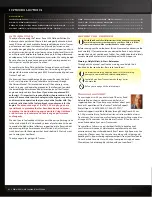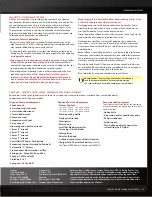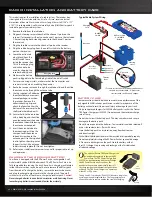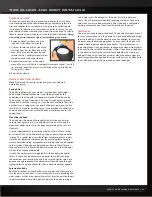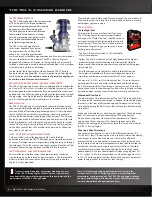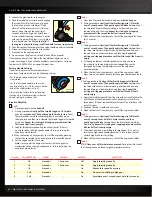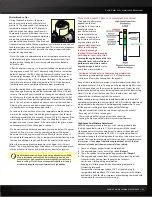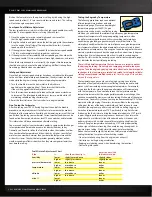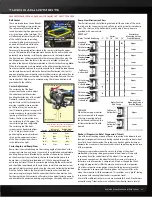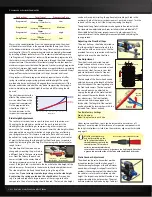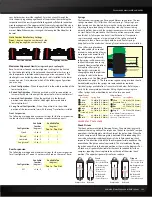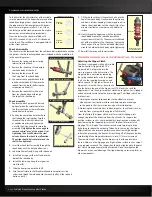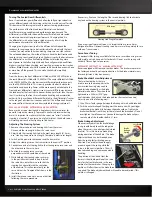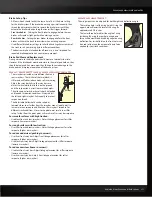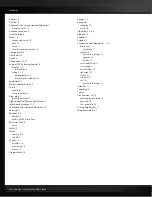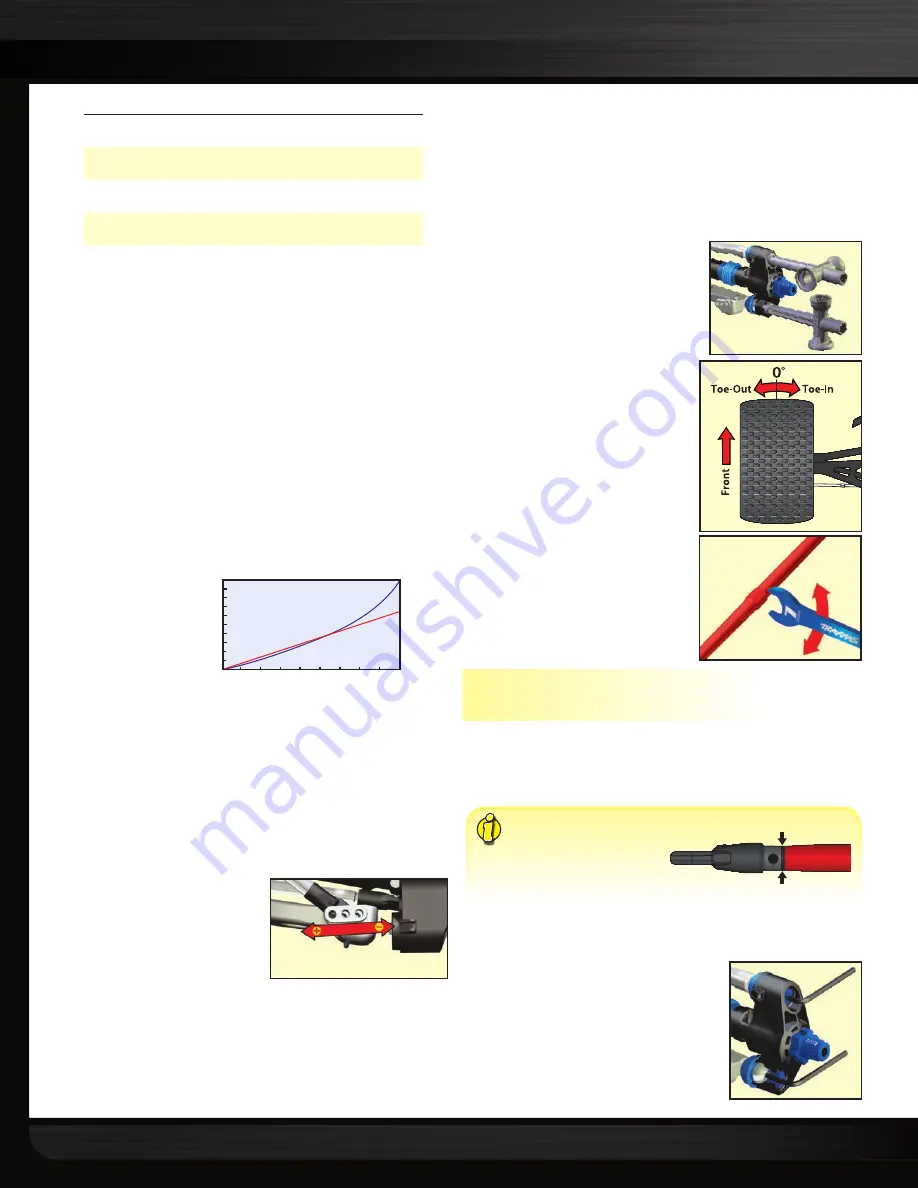
12 • REVO PLATINUM EDITION
90mm in the vertical direction. From the ride height position, the wheel
will be able to travel 60mm in the upward direction (bump), and 30mm
in the downward direction (droop). The Long Travel rocker arm increases
total travel to 120mm. The progressive rate can be increased or decreased
by installing different rocker arm sets. The rockers are labeled Progressive
1 to Progressive 3. Progressive 1 rockers will provide a low progressive rate
that maintains consistent damping force across through the whole range of
suspension travel. These are best for extremely rough terrain that requires
maximum suspension articulation. Progressive 3 rockers use high progressive
rate that will improve high-speed cornering on smooth surfaces by providing
a firmer feel. Body roll, brake dive and rear squat will also be reduced. Always
change all four rockers as a complete set. Do not mix rates and travel.
Using rockers with lower progressive rate may require the use of stiffer
springs to maintain proper spring pre-load and ride height. The spring
pre-load adjuster on each shock is designed for minor adjustments. If the
adjuster needs to be turned all the way down (compressing the spring) in
order to maintain proper ride height, then the next stiffer spring should
be used.
The chart demonstrates the
effect of the various rocker
arms on wheel force as the
suspension is compressed.
On the progressive rate,
wheel force is light at
first and increases as the
suspension is compressed.
Ride Height Adjustment
The rocker arm suspension uses push rods on each suspension arm.
Changing the length and/or position of the push rod adjusts the
ride height without affecting or compromising other suspension
parameters. For example, you can raise and lower the ride height without
changing up/down travel distribution, changing springs, or affecting
your progressive rate. This feature is unique to Revo and is extremely
beneficial in a racing environment where you can achieve a low center
of gravity (by lowering the ride height) without losing any suspension
capability. Increasing the ride height will increase ground clearance for
rough terrain.
The ride height of the model can be
changed by mounting the push rod in
a different hole in the lower suspension
arm. From the factory, the push rod
comes installed in the center hole of
the lower suspension arm’s push rod
mount. If the push rod is mounted in the inner hole, the ride height of the
vehicle increases. If mounted in the outer hole, the ride height decreases.
The ride height can be finely tuned by adjusting the sag of the
suspension.
Do not attempt to make large changes to the ride height
by adjusting the spring pre-load on the shock bodies.
If suspension
sag is severe and requires a large increase of the spring pre-load to
compensate, then a firmer spring should be used. The lowest ride height
can be achieved by installing the optional adjustable push rod in the
outermost hole of the lower suspension arm’s push rod mount. Turn the
rod ends all the way in until they stop (shortening the length).
The optional Long Travel rocker arms are designed to be used only with
the standard non-adjustable push rods installed in the hole labeled “LT”
(the middle hole of the lower suspension arm’s push rod mount). Any
minor adjustments to the ride height are accomplished by adjusting the
spring pre-load.
Adjusting the Pivot Ball Caps
The pivot ball caps should be adjusted so
that the pivot balls operate freely in the
axle carriers with no excess play. Use the
provided four-way suspension multi-tool to
tighten or loosen the pivot ball cap.
Toe Adjustment
The wheels can be adjusted to point
straight ahead or have a toe-in or toe-
out setting. To help you remember, look
down at your feet. For toe-in, your feet
point towards each other. For toe-out,
your feet point away from each other.
The toe angle of the front wheels can be
adjusted by varying the length of the toe
links that connect the steering linkage to
the front axle carriers. The toe angle of
the rear wheels can be adjusted by
varying the length of the metal toe links
that connect the rear bulkheads to the
rear axle carriers. The front toe links
and rear toe links are equipped with
turnbuckles. The lengths of the toe links
can be adjusted by turning them with the
included 7mm Traxxas wrench.
Toe Base Factory Settings
Front:
0-degrees
Rear:
1-degree toe-in each side
Under certain conditions, toe-in can be increased to a maximum of 3
degrees. To avoid potential interference of suspension components with
the long travel rockers installed, see the maximum alignment limits table
on page 13.
Static Camber Adjustment
The wheels can be set to have either positive
or negative camber (see illustration, page 13).
The camber angle changes as the wheel moves
up and down through its range of travel. Static
camber is the camber angle at the wheel when
the vehicle is set at its normal, stationary ride
height. The suspension pivot balls located in the
axle carriers adjust the static camber. The pivot
balls are protected by blue dust plugs. To adjust
Increases
Ride Height
Decreases
Ride Height
Rocker Arm
Total Travel
Progressive Rate
Progressive 1
90mm
(60mm up / 30mm down)
Low
Progressive 2
90mm
(60mm up / 30mm down)
Medium
Progressive 3
90mm
(60mm up / 30mm down)
High
Long Travel
120mm
(80mm up / 40mm down)
Low
8dchiVci
GViZIgVkZa
L]ZZa;dgXZ
%
'
)
+
-
&%
&'
&)
&+
&-
'%
&%
'%
(%
)%
*%
+%
,%
-%
.%
Egd\gZhh^kZ
GViZIgVkZa
TUNING ADJUSTMENTS
Left
Hand
Threads
Right
Hand
(Normal)
Threads
Decrease
Length
Increase
Length
All of the toe links were
originally installed on the
truck so that the left hand
thread indicators point in the
same direction. This makes it
easier to remember which way
to turn the wrench to increase or decrease toe link length. Note that
a groove indicates the side of the Tube with the left-hand threads.
Groove indicates left-hand threads
5304 Manual Work.indd 12
3/12/08 7:47:52 PM


